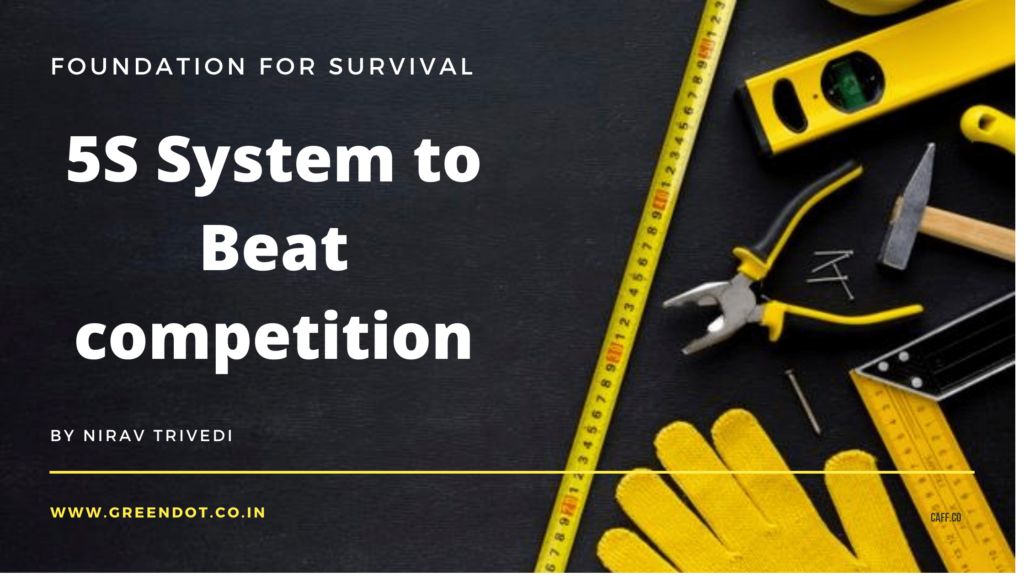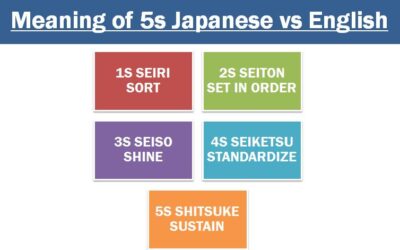
5s system implementation to beat competition
In this business world, client s
pecifications are always changing, new technology are continually being developed, and generation after generation of new products appear on the market.
Sales competition grows harsher each year as companies strive to manufacture more sophisticated products at lower cost.
Consumers keep asking for better quality products at lower price. Other side Labor cost, Material cost and govt taxes keep increasing. Cost of operation increased day by day.
The Seller’s market is no more. Buyers are ruling industries. Manufacturing industries must focus on services to differentiate them.
Challenged with living amidst such severe conditions, factories are desperate to find ways to ensure their survival. If they do not adapt to their changing environment, they Parish.
To survive factories must learn from the environment. They must destroy formal organizational concepts and customs that no longer apply and build up a more appropriate and stronger organisation.
However many of these concepts ingrained in production, sales and clerical work. With such deep roots they are not easily going to digest the 5s system. With this waste Company become fat & make difficult to survive in upcoming time
5s is a Japanese system that helps you organised your work station. 5s is considered as one of the housekeeping practices by many industries. This is a myth and not the real 5s. 5s is more intensive then just doing housekeeping.
The 5S approach arose from the need to meet the changing times and to support the resulting corporate restructuring it developed wirefire campaign undertaken at various progressive company in recent years
In Japan the five- S approach has become so familiar that it is hard to find the factory or office that has not implemented 5S partially or fully. Japanese companies use 5s practice to survive and grow their business.
What is 5s?

5s is a Japanese tool to help manufacturing industries as well as the service sector to improve its operating condition. 5s help industries to improve workplace productivity by eliminating waste. 5s system helps various types of industries to increase efficiency. 5s implementation makes the workplace brighter, shiner and more productive.
What is red tag strategy?
Red tagging means sticking “Tags” on pieces of paper on everything in factory that is waste.. Since we address red tag as a strategy. we therefore declare an enemy.Iin this case the name is waste.
Red tag strategies means taking every unneeded items that clogs up to the factory.
Let us begin with the inventory, most factories accumulate unnecessary inventory that is neither stored in the warehouse or stack between stations or at the production.
During our visit we have observed a 20 year old, useless inventory. Company owners or decision makers don’t want to take action on this inventory.
No matter how much you use less. People are not to be red tagged.
Implementation of 5s methodology by 5 Pillars of 5s tool. .
One cannot judge a factory’s 5S environment By poster or house keeping. 5S judgement only comes from observing the factory itself in most factories. Where I see organisation orderliness signs on display there are little more than decoration.
In fact as more people hear about organisations and orderly less you are really come to understand them
-
Seiri Or sort –
Organisation means clearly distinguishes between what is needed and to be kept and what is an needed and to be discarded
-
Seiton or set in order –
orderliness means organising the way needed things are kept so that anyone can find and use them easily.
The truth is that organisation and orderliness are not words to just discuss and neither are they meant to be printed on posters and banners. Organisations and orderliness activities things to be done
-
Seiso or Shine –
cleanliness means sweeping floors and keeping things in order. This is the kind of clean that most people carry out in their own homes.
We spend more time at the factory then at home. However we never keep anything tidy. However few cultured countries try hard to keep their nation clean.
In factory cleanliness is closely related to the ability to turn out quality products. Cleanliness should be integrated into daily maintenance tasks to combine cleaning checkpoints with maintenance check points.
The equipment operator is usually a person who best understands how well the equipment is operating and often only when the operator vipes dirt from the machine.
Does he or she notice that it is leaking oil or that a burning smell is coming from the control panel.
-
Seiketsu OR visual management –
it also means a visual control to prevent error, identify the hazards and make the organisation brighter, shiner, cleaner, well organised and productive. Visual workplace improvement is key.
standardized cleanup means that organisation orderliness cleanliness are being maintained
-
Shitsuske – Discipline –
The truth is that organisation and orderliness are not words to just discuss and neither are they meant to be printed on posters and banners organisations and orderliness activities things to be done
Best of my 20 years of Experience 5s implementation will not only improve the work area but also help improve the working environment. 5s practices must be implemented by any organization who looks forward to bringing changes in work culture and like to take their organisation to the next level.
Production process, sales, working condition, safety and quality will also improve. 5s is considered as one of the best & fundamental tools for lean.
I observed that, Many companies believe that the role of 5s consultant is crucial in 5s implementation. You bring the best 5s consultant, still you will not be able to get results if management is not determined to bring change. Regular 5s training and Motivation to each team member bring change in the workplace. The 5s system is easy and hard to implement.
 Greendot Management Solutions
Greendot Management Solutions
- SMART Goal Setting in Six SigmaSMART Goal Setting in Six Sigma A SMART goal is an acronym that stands for Specific, Measurable, Achievable, Realistic, and Time-bound. Thus, SMART goals integrate all of these criteria to help us increase the possibilities of achieving your goal. The project’s goals and objectives can be defined base on the project scope and problem statement. Goal Statement defines the expected improvement […]
- 12 Step of TPM Implementation12 Step of TPM Implementation| How to Implement TPM? Few Things we will cover in this post of 12 steps of TPM implementation How to Apply TPM (Total Productive Maintenance)? Preface of TPM 8 Pillars of Total Productive Maintenance Benefits of TPM (Total Productive Maintenance) 12 steps of TPM Implementation Also watch TPM Video:- https://www.youtube.com/watch?v=M-YccQYqRr4&t=22s […]
- Muda Mura MuriWhat’s Muda Mura Muri in Lean Manufacturing? The 3M methodology in Lean Manufacturing is basically used in the Toyota Production System. The 3M stands for Muda, Mura, and Muri. This is a Japanese Concept. The goal of Lean Manufacturing is to deliver increased value to the client with the help of barring all kinds of wastes from […]
- 7 Types of Abnormalities in TPM7 Types of Abnormalities in TPM Anything which isn’t normal that’s called an abnormality Fuguai is a Japanese word. Fuguai means abnormality. We can also say that the abnormality is a deviation from the standard requirement. The abnormality is a very much popular concept in Total Productive Maintenance (TPM). Several types of abnormalities are the part of Jishu Hozen Pillar in TPM Abnormality classify Matrix is also prepared in JH […]
- 8 Wastes of Lean ManufacturingWhat are the 8 Wastes of Lean? 8 Wastes of Lean are identified as Transportation, Inventory, Motion, Waiting, Overproduction, Over-processing, Defects, & Skillset or Non-utilized talent. Earlier it was considered as 7 waste of lean manufacturing too. We will cover the following topics in this blog The acronym we can say is TIMWOODS or DOWNTIME. What’s Waste in Process or Lean Manufacturing? […]
- Cost of Quality vs Cost of Poor Quality (COPQ)What’s the Cost of Poor Quality (COPQ)? It’s the cost related to providing poor quality products or services. In easy words, we can say that it’s the total financial losses incurred by the company due to doing the wrong things. COPQ is the cost that would disappear if in smooth operating conditions. It’s a refinement of the conception of COQ. […]
- What is Lean Six Sigma ?What’s Lean Six Sigma? Sigma (𝝈) is the Greek letter representing a statistical unit of measure that defines the standard deviation (SD) of a population. Six refers to the number of SD’s from the technical limit to the mean. It measures the variability or spread of the data. 6 sigma is a largely structured strategy. […]
- Six Big Losses in OEESix Big Losses in OEE and TPM The Six Big Losses are responsible for productivity. We’ve to exclude these to ameliorate productivity. One of the major goals of TPM ( Total Productive Maintenance) and OEE (Overall Equipment Effectiveness) is to reduce and eliminate Six Big Losses. Also refer to: https://www.youtube.com/watch?v=6ubu3vO1LDs&t=70s OR https://www.youtube.com/watch?v=M-YccQYqRr4 We will cover the following topics in this blog Classification of Big Losses Classification of Six Big Losses in […]
- Top Lean ToolsTop lean Manufacturing – Lean Operation Tools Top lean Tools are the methodical and scientific approaches for problem- working. Spare Tools are also used for relating and barring waste from the system or process. These tools are veritably important to apply Lean Manufacturing culture in the plant. Watch video on lean manufacturing crash Course just […]
- 5S in the Workplace | 5S ImplementationWhat’s 5S in the Work Place? 5S Methodology was developed in Japan and it’s a system for organizing spaces so work can be performed efficiently & effectively safely and it’s a fundamental tool of Lean Manufacturing It’s a system for organizing space so work can be performed efficiently & effectively with safely. Now and then it’s also […]
